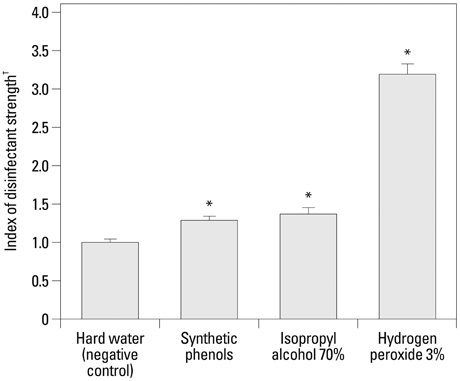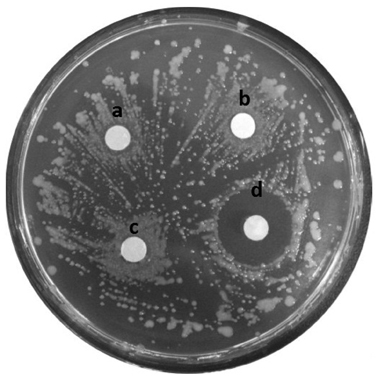Yonsei Med J.
2014 Jul;55(4):1152-1156. 10.3349/ymj.2014.55.4.1152.
Hydrogen Peroxide as an Effective Disinfectant for Pasteurella multocida
- Affiliations
-
- 1College of Life Sciences and Biotechnology, Korea University, Seoul, Korea. cwkim@korea.ac.kr
- KMID: 2130846
- DOI: http://doi.org/10.3349/ymj.2014.55.4.1152
Abstract
- Pasteurella multocida (P. multocida) infections vary widely, from local infections resulting from animal bites and scratches to general infections. As of yet, no vaccine against P. multocida has been developed, and the most effective way to prevent pathogenic transmission is to clean the host environment using disinfectants. In this study, we identified which disinfectants most effectively inhibited environmental isolates of P. multocida. Three readily available disinfectants were compared: 3% hydrogen peroxide (HP), 70% isopropyl alcohol, and synthetic phenol. In suspension tests and zone inhibition tests, 3% HP was the most promising disinfectant against P. multocida.
Keyword
MeSH Terms
Figure
Cited by 1 articles
-
Retraction: Hydrogen Peroxide as an Effective Disinfectant for Pasteurella multocida. Yonsei Med J 2014;55:1152-6
In-Soo Jung, Hyun-Jung Kim, Won-Yong Jung, Chan-Wha Kim
Yonsei Med J. 2016;57(1):274-274. doi: 10.3349/ymj.2016.57.1.274.
Reference
-
1. Brogden KA, Lehmkuhl HD, Cutlip RC. Pasteurella haemolytica complicated respiratory infections in sheep and goats. Vet Res. 1998; 29:233–254.2. Weber DJ, Wolfson JS, Swartz MN, Hooper DC. Pasteurella multocida infections Report of 34 cases and review of the literature. Medicine (Baltimore). 1984; 63:133–154.3. Hubbert WT, Rosen MN. Pasteurella multocida infections. II. Pasteurella multocida infection in man unrelated to animal bite. Am J Public Health Nations Health. 1970; 60:1109–1117.
Article4. Arashima Y, Kubo N, Iwasaki Y, Okuyama K, Kumasaka K, Tsuchiya T, et al. [Human respiratory tract infection by Pasteurella multocida subsp. multocida presumably derived from the cat]. Kansenshogaku Zasshi. 1990; 64:1200–1204.
Article5. Arashima Y, Kumasaka K, Tsuchiya T, Kawano K, Yamazaki E. [Current status of Pasteurella multocida infection in Japan]. Kansenshogaku Zasshi. 1993; 67:791–794.
Article6. Yun JH, Back HJ, Jin HJ, Son YW, Kwak SY, Yang HJ, et al. Bacterial distribution and antimicrobial resistance pattern of PC room (Internet Cafe) in Seoul, Korea. Korean J Microbiol. 2005; 41:183–187.7. Cozad A, Jones RD. Disinfection and the prevention of infectious disease. Am J Infect Control. 2003; 31:243–254.8. Block SS. Disinfection, sterilization and preservation. Philadelphia: Lea & Febiger;1991. p. 167–181.9. McDonnell G, Russell AD. Antiseptics and disinfectants: activity, action, and resistance. Clin Microbiol Rev. 1999; 12:147–179.
Article10. Larson EL, Morton HE. Disinfection, sterilization, and preservation. Philadelphia: Lea & Febiger;1991. p. 191–203.11. HE M. Disinfection, sterilization and preservation. Philadelphia: Lea & Febiger;1983. p. 225–239.12. Herńndez A, Martró E, Matas L, Martín M, Ausina V. Assessment of in-vitro efficacy of 1% Virkon against bacteria, fungi, viruses and spores by means of AFNOR guidelines. J Hosp Infect. 2000; 46:203–209.
Article13. Poole K. Mechanisms of bacterial biocide and antibiotic resistance. Symp Ser Soc Appl Microbiol. 2002; (31):55S–64S.
Article14. Romão CM, Faria YN, Pereira LR, Asensi MD. Susceptibility of clinical isolates of multiresistant Pseudomonas aeruginosa to a hospital disinfectant and molecular typing. Mem Inst Oswaldo Cruz. 2005; 100:541–548.
Article15. Herruzo-Cabrera R, Vizcaino-Alcaide MJ, Fernández-Aceñero MJ. The influence of laboratory adaptation on test strains, such as Pseudomonas aeruginosa, in the evaluation of the antimicrobial efficacy of ortho-phthalaldehyde. J Hosp Infect. 2004; 57:217–222.
Article
- Full Text Links
- Actions
-
Cited
- CITED
-
- Close
- Share
- Similar articles
-
- Retraction: Hydrogen Peroxide as an Effective Disinfectant for Pasteurella multocida. Yonsei Med J 2014;55:1152-6
- A Case of pasteurella multocida pleural empyema
- Pasteurella multocida isolation from pigs with respiratory disease in Korea
- Meningoencephalitis and pneumonia caused by Pasteurella multocida in rabbits
- A case of spontaneous bacterial peritonitis and sepsis due to Pasteurella multocida in a patient with liver cirrhosis



